Building Capacity in Industry: Recruiting and Retaining Employees with Disabilities (2016)
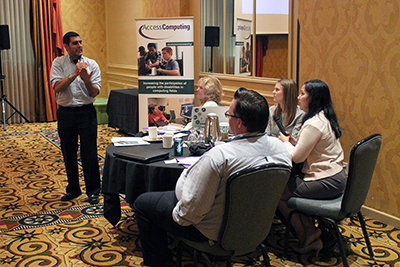
Proceedings of the April 2016 AccessComputing Capacity Building Institute (CBI)
The Alliance for Access to Computing Careers (AccessComputing) coordinates multiple activities to increase the participation of people with disabilities, including veterans, in computing and information technology (IT) postsecondary education and career fields. AccessComputing is led by the Department of Computer Science and Engineering, the Information School, and the DO-IT (Disabilities, Opportunities, Internetworking, and Technology) Center at the University of Washington (UW) and is funded by the Computer and Information Science and Education (CISE) program of the National Science Foundation (grant #CNS-1042260, CNS-1539179).
This publication shares the proceedings of Building Capacity in Industry: Recruiting and Retaining Employees with Disabilities, an AccessComputing-sponsored CBI that was held June 15 – 17, 2016 in Seattle, WA. The content may be useful for people who
- were participants in the CBI,
- are employers who are interested in recruiting and retaining employees with disabilities,
- are disability service and career service providers in higher education,
- are motivated to engage in an electronic community to discuss these issues, and/or
- have promising practices to share with others.
About AccessComputing
AccessComputing works to increase the participation of people with disabilities in computing and IT fields. Institutional and organizational partners apply evidence-based practices to
- increase the number of students with disabilities successfully pursuing degrees and careers in computing fields;
- increase the capacity of postsecondary computing departments to fully include students with disabilities in computing courses and programs;
- increase the capacity of employers to recruit and retain employees with disabilities in computing-related employment;
- encourage computing educators to teach about accessibility and universal design in the computing curriculum;
- create a nationwide resource to help students with disabilities pursue computing fields; and
- help computing educators and employers, professional organizations, and other stakeholders develop more inclusive programs and share effective practices nationwide.
Institutional partners are Auburn University, Carnegie Mellon, Clemson University, Cornell Tech, DePaul University, Gallaudet University, Georgia Institute of Technology, Landmark College, National Technical Institute for the Deaf, New Mexico State University, North Carolina State University, Old Dominion University, Portland State University, Rochester Institute of Technology, Southern Illinois University Edwardsville, Towson University, University of Alabama, University of California Santa Cruz, University of Colorado Boulder, University of Maine, University of Maryland, University of Maryland Baltimore County, University of Nevada Las Vegas, University of Nevada Reno, University of Portland, University of Washington, and Washington State University.
Organizational partners are the Alliance for Students with Disabilities in Science, Technology, Engineering, and Mathematics (AccessSTEM); the Anita Borg Institute, the Center for Minorities and People with Disabilities in Information Technology (CMD-IT); the Computer Science Teachers Association (CSTA); the Computing Alliance of Hispanic-Serving Institutions (CAHSI); the Computing Research Association (CRA); Expanding Computing Education Pathways (ECEP); the Institute for African-American Mentoring in Computing Sciences (iAAMCS); Into the Loop; the National Center for Women and Information Technology (NCWIT); the National Girls for Collaborative Project (NGCP); and the STARS Computing Corps.
Industry partners are companies that are working to make the technical workplace more welcoming and accessible to computing professionals with disabilities. Companies learn about strategies that can be successful in recruiting and retaining employees with disabilities. Industry partners include Yahoo! and Salesforce.
AccessComputing engages with project partners by
- conducting CBIs focused on increasing the participation of students with disabilities in computing and IT academic programs and careers,
- sharing the results of the CBIs with other institutions and individuals who serve students with disabilities,
- providing an electronic forum to continue discussion of issues for students, including veterans, with disabilities and increase services and supports for these students, and
- extending resources to other programs and promising practices via an online searchable Knowledge Base.
About the CBI
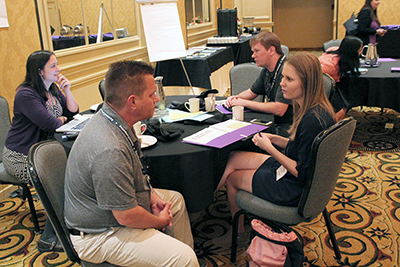
Building Capacity in Industry: Recruiting and Retaining Employees with Disabilities was held in Seattle, WA on June 15-17, 2016. Its purpose was to encourage efforts to make industry careers more welcoming and accessible to individuals with disabilities. Attendees included computing students and professionals with disabilities, computing employers, disability experts, and professional organization representatives.
As is typical of a CBI,
- all participants contributed to its success;
- speakers participated in group discussions;
- experts in all topic areas were in the audience; and
- participants gave presentations and participated in large and small group discussions.
- some predetermined professional development was presented, new content was delivered as the meeting unfolded, and participant interests were expressed and expertise was made known.
The CBI provided a forum for discussing recruitment and access challenges, sharing expertise and successful practices, developing collaborations, creating resources, and identifying systemic change initiatives relevant to the meeting’s goals.
Topics discussed include
- the experiences of computing students and professionals with disabilities,
- activities designed to recruit and retain employees with disabilities, and
- best practices for making companies welcoming and accessible to students with disabilities.
The agenda for the CBI and summaries of the presentations, panels, and working group discussions are provided on the following pages.
CBI Agenda
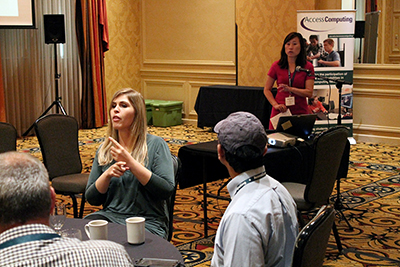
Wednesday, June 15
7 – 9 pm
Networking Reception
Thursday, June 16
8 – 9 am
Breakfast and Networking
9 – 10
Welcome, Overview, and Introductions
Sheryl Burgstahler & Richard Ladner, University of Washington (UW)
10 – 11
Overview: People with Disabilities in Education and the Workforce
Richard Ladner
11:15 – 12:15
Panel of Computing Professionals with Disabilities
Panelists: Katie Sullivan, Microsoft; Sean Marihugh, Microsoft; Jessie Shulman, Expedia; Joel Isaac, JP Morgan Chase
Moderator: Brianna Blaser, UW
12:15 – 1:00
Working Lunch
Discuss at your table: What barriers exist in recruiting employees and interns with disabilities? How can these challenges be overcome?
1:00 – 1:30
Report Out
1:30 – 3:15
Short Presentations
Disability Disclosure in Employment – Susann Sears, University of Illinois at Urbana Champaign
Microsoft’s DisAbility Initiatives – Jen Guadagno & Devan Vaughn, Microsoft
Mentorship and Hiring Best Practices – Sam Sepah, Google
3:30 – 4:15
Large Group Discussion
What can companies do to support interns and employees with disabilities and ensure they have access to equal opportunities (e.g., promotions)?
4:15 – 4:45
AccessComputing Resume Database Design Feedback
Terrill Thompson, UW
4:45 – 5:00
Preview of Dinner Tonight and Tomorrow’s Topics
6 – 8 pm
Dinner
Discuss at your table: How can interns and employees with disabilities serve to enrich a company?
Friday, June 17
8 – 9 am
Breakfast and Networking
9 – 9:15
Daily Overview
9:15 – 9:45
Report Out on Dinner Discussion
9:45 – 10:30
Roundtable Discussion – Assistive Technology and Accessibility
Presenters: Imran Ahmed, Bosma Enterprises; Dan Comden, UW; Terrill Thompson, UW
Moderator: Sheryl Burgstahler, UW
10:30 – 11
Supporting Neurodiverse Software Engineers in Technical Workplace Settings
Meredith Ringel Morris – Microsoft Research
11 – 12
Large Group Discussion: What resources would better enable you to recruit and retain interns and employees with disabilities? How can AccessComputing support these efforts?
12 – 1
Lunch, Networking, and Discussion
How can we continue to work together to promote the inclusion of individuals with disabilities in the tech industry?
Presentation Summaries
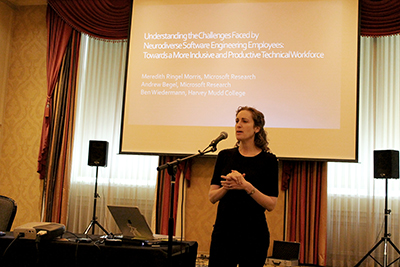
Overview: People with Disabilities in Education and the Workforce
Presenter: Richard Ladner, University of Washington
By increasing access to allow higher numbers of people with disabilities in the college/university setting and workplace, we allow a substantial population—15 percent of the world’s population—the ability to participate. Though there are many people with disabilities already succeeding in PhD programs and challenging careers, these numbers are still much lower than their representation in the general population.
According to the World Health Organization, a disability is not primarily a health problem, but rather defined by the ability to interact with the environment and as well as social barriers that prevent people with disabilities from fully participating in society. While K-12 education has made great strides in including people with disabilities, only ten percent of college students and four percent of graduate students have disabilities.
Innovations for access to people with disabilities often become solutions for the wider population. Examples of this include personal texting, speech recognition, and video chat. Personal texting and Picturephone were both originally created in the 1960’s for deaf people to communicate over distances; speech recognition was originally created for people who could not type easily. These technologies are now used by many people daily (e.g., iOS’s Siri). Disability and technology innovation are intertwined, and more mainstream technology products have accessibility features built-in.
Throughout the years, people with disabilities have been excluded, institutionalized, and accommodated, which is a reactive approach. Today we can apply universal design, a proactive approach that considers the needs of all people with all types of abilities and disabilities from the beginning stages of design. Companies often only look at accessibility as a compliance issue. Instead, companies should view this issue in a more welcoming light—how can we be more inclusive and welcoming to that 15 percent of the population is often be left out?
Supporting Neurodiverse Software Engineers in Technical Workplace Settings
Presenter: Meredith Ringel Morris, Microsoft Research
Autism is becoming more and more common—1 out of 68 children is on the autism spectrum with widespread abilities in a variety of functions. Many people with autism excel in school and hold highly competitive jobs.
By considering neurodiverse (attention deficit disorder, autism spectrum disorder, and/or learning disability) employee candidates, companies can open doors to untapped talent pools. People with autism often have qualities praised in the technology world. But what can be done for people with autism to maximize their potential in the technology industry?
When Microsoft Research interviewed people on the autism spectrum, we attempted to look into the issues of neurodiversity in the workplace. Only half of these individuals had disclosed their disability to their employer, sometimes because of potential stigma and discrimination. Most people who are neurodiverse had challenges arise due to a literal interpretation of the rules and miscommunication. Furthermore, these individuals claimed if they found something uninteresting they often became disengaged or felt uncomfortable in team-building exercises. Accommodations that people on the autism spectrum requested revolved around travel, written instructions, private meetings with a manager, working from home, and awareness from colleagues.
A larger survey was sent to 2600 employees from Microsoft. 846 completed the survey; 85% of these were male, with 7% stating they were neurodiverse. This survey helped us learn about the differences between technology workers who are neurodiverse and those who are not.
We’ve learned that there are many people on the spectrum who do not disclose their disabilities. Educating all employees about neurodiversity and creating a culture of acceptance of difference will help remove stigma and encourage people to disclose. Also allowing for a variety of office settings and communication methods can make employees feel more comfortable in their workplace and better focus on their work.
To learn more details about this research, please read the full report available at research.microsoft.com/en-us/um/people/merrie/papers/neurodiverse_tech_employees_assets2015.pdf.
Disability Disclosure in Employment
Presenter: Susann Sears, University of Illinois at Urbana Champaign
This presentation focused on when to disclose one’s disability, how to create a disability disclosure statement, and the pros and cons of disclosing. This content may help employers understand how potential employees may approach the disclosure process.
It is the employee’s responsibility to ask for an accommodation, which requires the employee to disclose their disability. 70 percent of workplace accommodations can be made for less than $500. Companies can only claim undue hardship if an accommodation would be very expensive or nearly impossible to provide.
A person with a disability may disclose before or during an interview, after hiring, when an accommodation is needed, or never. Disclosing a disability too early may prevent a person from getting an interview. However, for some people it is important to be proactive in disclosing to ensure an interview location is accessible, to arrange for a sign language interpreter, or to frame a disability as a strength.
When requesting an accommodation, employees should be clear and concise about what is needed and how the accommodation positively affects work performance. Though employers can be apprehensive about costs or behaviors when it comes to disabilities, it helps when the employee builds a relationship of trust and confidence.
Microsoft’s DisAbility Initiatives
Presenter: Jen Guadagno & Devan Vaughn, Microsoft
People with disabilities have a lot of untapped potential. Microsoft is expanding and building an inclusive workplace environment; we have put in place multiple programs in order to hire more people with disabilities. Through these programs and other strategies related to people with disabilities, we can create a culture of inclusivity and accessibility. Through these efforts, we have been able to do the following:
- actively recruited people with disabilities
- included universal design in the product design process
- hosted an Ability Career Fair and brought information on our inclusive hiring to other career fairs on university campuses and at industry events
- as a part of our annual Hackathon event, hosted numerous “ability hacks” that focus on accessibility and inclusion
- offered a disAbility scholarship each year since 2013 to support a student with a disability pursuing a college degree
Finally, we run the Autism Inclusive Hiring Program. This program educates recruiters, hiring managers and interviewers on what to expect in working with job candidates on the autism spectrum. It also allows for a different approach to hiring, including a different view on resumes, phone interviews, and technical assessments. There is a 1-2 week, in-person hiring event so that qualified candidates can participate in team projects and prepare for interviews in a relaxed atmosphere. Once hired, employees in this program a matched with a team of mentors to help them navigate their new position and the Microsoft culture.
Mentorship and Hiring Best Practices
Presenter: Sam Sepah, Google
In my personal life, I worried that my disability was a barrier to getting hired. I had a personal connection who continually got me into interviews, and it took me a few interviews to finally get an internship working in human resources (HR). My connection saw me as more than my resume and helped me work through my concerns in order to find a career in HR.
In a study of the barriers listed by employers to hiring people with disabilities, the top 5 barriers include these:
- lack of qualified applicants
- lack of related experience
- lack of requisite skills and training
- inadequate supervisor knowledge of accommodations
- cost of accommodations
Best practices to increase hiring people with disabilities include the following:
- offering internships for people with disabilities
- having strong management commitment
- including people with disabilities in organizational goals
- actively recruiting people with disabilities
- including people with disabilities in a diversity plan
Employers should address the 3 R’s: recruiting, retaining, and recognizing. If you get involved in recruiting and hiring people with disabilities at your company, more applicants with disabilities will apply for jobs in your company. Employees with disabilities can help to recruit people with disabilities, support a disability-focused employee network, and create partnerships with disability-related advocacy organizations. Ideally, the employer will create a centralized accommodation fund to ensure that departments hiring an individual with a disability do not bear the burden of accommodation costs, provide a formal process for requesting and receiving accommodations, and create an inclusive culture.
Having a team of mentors helps a person to have a great career. It is also important for an employ to become an advocate for others and create a welcoming environment for all. This leads to an inclusive workplace. All employees should have to take a cultural training, have more accountability by creating a plan to follow, and have opportunities for advancement. At Google, we offered an ASL class and, within 48 hours, over 160 people had signed up. You won’t know what your employees will want to take until you offer it, and it makes everyone feel more included in the culture.
Roundtable Discussion – Assistive Technology and Accessibility
This discussion featured Terrill Thompson, University of Washington; Dan Comden, University of Washington, and Imran Ahmed, Bosma Enterprises. It was moderated by Sheryl Burgstahler, director of DO-IT and co-PI for AccessComputing.
There are thousands of different types of assistive technologies. Employers should be in the general practice of asking all new employees what kinds of tools they use to make their job easier. Does an employee use a screen magnifier, speech recognition, text-to-speech software, or braille? No employer is going to be an expert in all technologies and know what to offer to an employee, especially someone with a disability. A person with a disability has the responsibility to be the expert on their own needs and tools; however, it is important that employers offer employees the opportunity to learn more about technologies and tools they could use.
The CSUN Annual International Technology and Persons with Disabilities and Closing the Gap conferences are both great places for employees to learn about different technology and how to use a diverse range of tools. No one will ever be an expert on all technology, but at a conference they can witness the richness of the field.
If you want to design products that work with assistive technology, keyboard functionality is the most important quality to consider. Many assistive technologies support keyboard use alone. The Web Content Accessibility Guidelines 2.0 (WCAG 2.0) of the World Wide Web Consortium should be followed for development of web content and software . The WCAG 2.0 basic success criteria gauge whether something is accessible or not. And just because something is technically accessible, does not mean it is usable. Usability requires that someone can effectively use a product in the way it was intended.
What are some of the issues with making PDFs and forms accessible?
Portable Document Format (PDF) files follow similar guidelines to websites—heading styles, accessible tables, alt text for images, etc. But accessibility guidelines are not always intuitive for creators to use and people with disabilities are often left out of the conversation. Some employers struggle with the tools they have to create accessible documents. Employers need to learn the basics of document accessibility so they can at least start to include people with disabilities, both internally and externally.
However, reactively making documents and videos accessible are expensive accommodations. Having accessible documents and captioned videos already in place not only is cheaper and easier, it creates a welcoming culture where people do not have to request accommodations. These accessibility features are often helpful for those who do not have difficulties.
Captioned videos are a necessity for individuals who are deaf or hard of hearing. Who else benefits from captions?
Captions benefit everyone one when new terminology is spelled out. They can be repurposed as transcripts and are searchable. Communication access real-time translation (CART) can be helpful for everyone attending an event because even if you stop paying attention, you can look back on the text to see what was missed. CART can also be used remotely, so people can discreetly use it, or look at the transcripts later.
What is happening in today’s world for smart phone accessibility?
Mobile technology is only getting more popular—this is great because phones already have many accessibility features built in. It gets easier and easier to build an accessible mobile app. Apps are simpler than desktop software and usually feature bigger displays or aspects that work with a phone’s built in features.
What can we do to make sure the tools to create are also accessible to people with disabilities?
We should promote accessibility across the board so that the means of creation should become more and more accessible as well. The mentality of universal design means all products, both internal and external, should be as accessible as possible.
Panel Presentation Summary
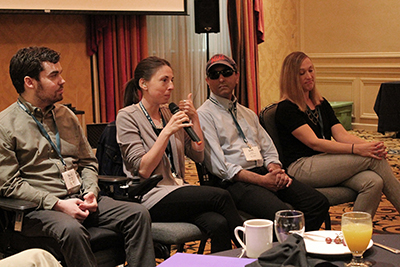
Panel of Computing Professionals with Disabilities
Panelists included Katie Sullivan, Microsoft; Sean Marihugh, Microsoft; Jessie Shulman, Expedia; and Joel Isaac, JP Morgan Chase.
How does your disability impact your education or career?
- My disabilities impacts the way I consume and output information. My learning disabilities make me process information differently than other people and I need more time to read email and other documents. I spend more time scheduling and making sure I have time to do these tasks.
- Through my transition from seeing to not seeing, I have learned that things in an electronic format are the best. I can lose information when people are speaking and pointing and referencing things in the room. I can’t lose information as easily if it’s electronic.
- I’ve had issues with communication being deaf. I often have to prepare more before meetings, whether it is arranging for captions or an interpreter. I try to share the captioning or video experiences I have with the others I’m having a meeting with so we’re on the same page.
- I have to make sure things are always physically accessible; advanced notice is key to make these changes. I have to request my office is set up a certain way, travel is planned in advance, etc.
When did you choose to disclose your disability to your job?
- I’m on an accessibility team. I figured I didn’t need to disclose until I met them, because I knew they’d be welcoming. When I was scheduled for my last job, I was hired through the Federal Government’s Schedule A hiring system, which is non competitive, so I had to disclose my disability.
- Because I need an American Sign Language (ASL) interpreter, I disclose before the interview so they know what to expect and what to do when we’re in the interview.
- It’s very situational and depends on your disability. When you have an invisible disability, it’s often a more complicated question. If I’m talking to a recruiter, I probably won’t disclose. If I’m talking to the direct hiring manager, I usually will, since they have to directly work with me and my disability. I often try to weave my disability into the job I’m applying for and share how it helps with my job preformance instead of hinders it.
- I usually disclose right when I’m hired so I can get the accommodations I need immediately, but it’s often on a case-by-case situation.
Have you had a negative issue with your disability and your employer?
- Since I have been progressively losing vision, I have had a hard time recognizing that I was changing or needing more accommodations. It took me six months to really admit to myself that my vision had changed. I had to start asking for help. I made it a negative experience for myself because I was worried about the stigma.
- I’m a terrible speller because of my disability, and I have a lot of anxiety about doing work in front of people and writing on the board. I’ve been embarrassed in front of other people before in the workplace.
- Deaf people may have a lot of accommodations, and this can be really hard for impromptu events. I always felt like I was missing out on those quick hall conversations—but I’ve quickly learned that people are willing to actively find me to talk about things.
- People with mobility issues often get extra scrutiny about whether they can actually travel on the job.
What do you wish employers knew to better retain employees with disabilities?
- Employers should create employee resource groups for people with disabilities and learning about assistive technology options.
- Employers should be open to talking about accommodations and the things that can be done to keep me engaged in the job.
- Employers need to be aware of the whole process. If the recruiter doesn’t know there are resources for people with disabilities, they won’t be as welcoming to people with disabilities.
- I was able to participate in a lot of internships in college that helped me test out my skills and the things I had learn and the tools I needed in the workplace. This really helped me know what jobs were right for me and what I needed once I got there.
- Schedule A and special inclusive hiring processes need to be well understood and employers need to know how to articulate these practices.
- Employers should break down workplace stigma about disabilities. Even before hiring a person with a disability, have differences in employee strengths and weaknesses and accommodations talked about in the workplace.
How do you feel about employers asking if you have a disability on applications? What is the ideal response to receive when you disclose?
- If employees are aware you’re looking for people with disabilities, they’re more willing to disclose and start that discussion—it’s all about how you explain how the information will be used.
- I am often turned off by that question because there’s always a huge disclaimer. It seems like a negative question, so I never want to answer.
- Do I make myself look like a weak candidate by disclosing my disability before even meeting a person? This is what I ask when I’m answering that.
- When I disclose, I want a supportive response, “Great, we have all these resources and this is how to get accommodations.” I want to be welcomed and hear about how I will be successful with that company. If I don’t get a response at all or a negative one, it worries me how it will be once I start the job.
- Managers should talk about all the resources they have to offer to all employee candidates, but also say you don’t have to take them.
How do you get involve more people with disabilities in the conversation and make the first encounter more welcoming?
- Most of my experiences have had me starting with an email for what I need from people for meetings, and people try to give me time to let me know when they’re planning on doing something.
- We tend to congregate with people who look and act like us, but once people start working with a person with a disability, they’re more welcoming. It’s better to be open and show people how to interact with you rather than hide it.
- A lot of my accommodations can also be very helpful to other people—taking digital notes and making action items, for example. People learn to appreciate these accommodations as a helpful collaborating tool.
- One of my managers had a disability as well, and she actually came in to talk to me and offered for us to host a workshop on my disability for my team, and I found that very welcoming and helpful to have someone there helping me navigate it.
How do you get people with disabilities applying for more jobs?
- When an employer hosts a specific career fair for people with disabilities with actual employees from the company, it creates a welcoming atmosphere and encourages more people to apply.
- Targeted outreach is very helpful—how do we take advantage of existing efforts to hire students with disabilities?
- Partnering with AccessComputing is a great way to connect students with disabilities with employers looking to hire people with disabilities.
How would you help combat bias in the workplace and build a better culture of acceptance at your workplace?
- Global Accessibility Awareness Day (GAAD) was created to help promote a better accessibility culture in the workplace and the public. We try to do something each year for GAAD where we can show others and teach our workplace and more about accessibility.
- People with disabilities hired into an organization can often be assumed to work in accessibility, or when a product is tested, they go to the people with disabilities first as the “model” of accessibility. Employers shouldn’t just assume people with disabilities are the know all/say all for disability culture or technology use..
- It’s okay to own your disability and use it as a strength. Creating a culture that accepts strengths and weaknesses is important.
- Disability resource groups should have hidden memberships so you don’t know who is in that group. This allows people to participate before disclosing.
- I used to think employee resource groups (ERGs) weren’t for me, but lately I’ve been more involved and learned that they really can make a difference and give a perspective on different aspects of my job. Working as a group makes my work more valuable because I have more input, and my work can be used by others. Sharing those resources gives more support for all of us.
- Resource groups have provided opportunities to me, like meeting with students and sharing my experiences, or meeting with others to share our issues and learn more from them together. Sharing the value of what is in a ERG and discussion group provides feedback for tools and accessibility of resources as well.
How do we make a business case for accessibility and those resources? How do you turn a positive response into funding, opportunities, and standards for our companies?
- Make sure managers are open to these resources and getting on board for employees participating. These mentalities often trickle down—if management gets on board, the employees will as well.
- Staffing, outreach for events, funding should all be considered—employees can only do so much because they need to do their main job. We need staff specifically signed on for these resource groups and more funding for these efforts.
- Continually push inclusivity as an important message for the company.
- The more people you get invested in accessibility, the more you won’t even have to bring it up—accessibility will be second nature to all people in a company.
Working Group Discussion Summaries
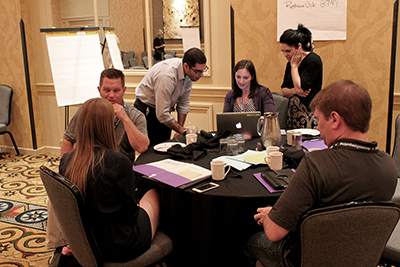
Discussion points made during group collaboration are presented below.
What barriers exist in recruiting employees and interns with disabilities? How can these challenges be overcome?
- Inaccessible websites—which can be overcome with more promotion of website accessibility.
- Connecting with the right people in higher education for recruiting students with disabilities; we’ve often had problems with the disability resource services not sharing our information to students or connecting us to interested prospects.
- Finding the right social agencies to work with—We could connect with Division of Vocational Rehabilitation and Veterans Service offices, as well as Centers for Independent Living. The American Association for the Advancement of Science EntryPoint! Internship program also has opportunities to connect students with internships.
- Creating an environment that is welcoming and where students feel comfortable disclosing their disability can attract more students with disabilities to consider us as an employer.
- Finding students to apply can be hard—hosting a career fair or a special hiring program specifically for students with disabilities can create more opportunities to connect with those students and showcase a welcoming and accessible environment.
- Inaccessible job applications that make it impossible for a person with a disability to apply.
What can companies do to support interns and employees with disabilities and ensure they have access to equal opportunities (e.g., promotions)?
- Offer job training and opportunities for all employees, emphasizing that opportunities are open to all.
- Have a central fund for accommodations because it separates the cost of accommodations from the actual departmental costs. This allows a person with a disability to not feel like a drain on their team.
- Have a strong mentor circle can be important—facilitating that mentorship and integration into the work culture allows people to reach out and move up in a company. Having a good relationship between an employee and a manager makes the employee feel comfortable about discussing job opportunities.
- Promote employees taking professional development and attending workshops.
- Make sure all internal products are made accessible so people within the company don’t get kept from information or passed up for a promotion because they weren’t able to access the same resources.
- Train employees and managers on unconscious bias and create a culture around helping each other.
How can interns and employees with disabilities serve to enrich a company?
- Having an employee with a disability makes it more normal for people to acknowledge their weaknesses and open up to each other about strengths and weaknesses.
- People with disabilities often think outside the box and think up different solutions to problems that may not be seen otherwise.
- It can promote a culture of accessibility and diversity.
- It allows people to feel more comfortable being adaptable and take on different roles.
- People with disabilities often create a better safe place for sharing thoughts and ideas.
- Opening the conversation up around disability encourages all design processes to be accessible and to include accessibility in all external products made.
- It makes a statement that your workplace adapts accessible culture and supports people with disabilities.
What resources would better enable you to recruit and retain interns and employees with disabilities? How can AccessComputing support these efforts?
- Create a package that showcases what AccessComputing is and ways to support people with disabilities in the workplace. Create an ad for becoming a partner for AccessComputing.
- Help companies learn about reasonable accommodations and provide information on website accessibility.
- The AccessComputing knowledge base that has Q&As for higher education should include more resources for company culture and hiring people with disabilities.
- Hold workshops and panels of professionals with disabilities to teach companies about accessibility or how to hire people with disabilities.
- Offer opportunities to connect with other companies on accessibility and build relationships across companies about accessible products and hiring.
- Create a webinar geared at HR and recruitment where individuals can engage and ask questions.
- Encourage people to communicate online to keep the conversation going.
CBI Participants
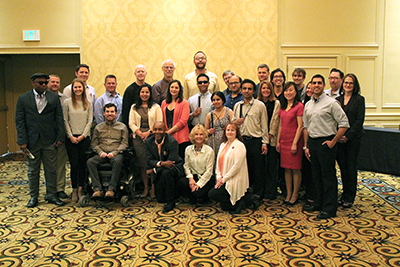
Stakeholder groups represented in the CBI included
- student service leaders and administrators,
- faculty members,
- students, and
- professional organizations.
The following individuals participated in the CBI.
Imran Ahmed
Jaws Script Writer and Assistive Technology Instructor
Bosma Enterprises
Hina Altaf
Assistive Technology Specialist
Center for Sight & Hearing
Chetan Bakhru
Senior Accessibility Specialist
JPMorgan Chase
Anthony Baylis
Director, Office of Strategic Diversity and Inclusion Programs
Lawrence Livermore National Laboratory
Jeff Bigham
Associate Professor
Carnegie Mellon University
Brianna Blaser
Program Coordinator
AccessComputing, University of Washington
Sheryl Burgstahler
Co-PI
AccessComputing, University of Washington
Scott Burlingame
Executive Director
Independence Inc.
Matt Coin
Recruiting Manager
Salesforce
Lyla Crawford
Program Coordinator
AccessComputing, University of Washington
Marvin Crippen
Computer Systems and Web Specialist
University of Washington
Michael Forehand
Recruiter
Boeing, Global Staffing
Jen Guadagno
Inclusive Hiring Program Manager
Microsoft
Shaun Helkey
Employment Consultant
PROVAIL
Jean Hodgson
Employment Consultant
PROVAIL
Joel Isaac
Sr. Accessibility Specialis
JP Morgan Chase
Amy J. Ko
Co-PI, Associate Professor
AccessComputing, University of Washington
Blake Konrady
Employment Services Manager
PROVAIL
Richard Ladner
PI, Professor
AccessComputing, University of Washington
Christopher Langston
User Experience Researcher – Accessibility
Pearson
Elizabeth Lee
Publications Coordinator
AccessComputing, University of Washington
Sean Marihugh
Escalation Engineer
Microsoft
Matt May
Sr. Program Manager, Accessibility,
Adobe
Jywanza Maye
Department of Defense
Meredith Morris
Senior Researcher
Microsoft Research
David Nichols
Technical Services Manager
Skills Inc
Susann Sears
Acting Director
University of Illinois at Urbana Champaign
Sam Sepah
Technical Recruiter
Google
Ady Sharma
Senior Corporate Recruiter
Boeing
Laura Steele
Deputy Director
Blue Water Center for Independent Living
Terrill Thompson
Technology Accessibility Specialist
Accessible Technology Services, University of Washington
Devan Vaughn
Program Manager - Global Talent Acquisition
Microsoft
Jacob Wobbrock
CO-PI, Associate Professor
AccessComputing, University of Washington
Resources
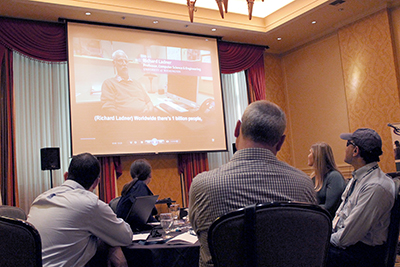
The AccessComputing website contains
- information about project goals,
- the application of evidence-based practices toward project deliverables,
- resources for students with disabilities,
- educational materials for postsecondary faculty and staff,
- information about partners and collaborators, and
- program applications.
AccessComputing maintains a searchable database of frequently asked questions, case studies, and promising practices related to how educators and employers can fully include students with disabilities in computing activities. The Knowledge Base can be accessed by following the “Search Knowledge Base” link on the AccessComputing website.
The Knowledge Base is an excellent resource for ideas that can be implemented in engineering programs in order to better serve students with disabilities. In particular, the promising practices articles serve to spread the word about practices that show evidence of increasing the participation and success of people with disabilities in computing.
Examples of Knowledge Base case studies, promising practices, and questions include
- How can I make my computing department more accessible to students with disabilities?
- What adaptive technology is typically provided to students with disabilities on postsecondary campuses?
- What are specific computer applications that can assist students with learning disabilities?
- Are there any web-based tutorials on accessibility?
- How can principles of universal design be used to construct a computer lab?
- Are there scientific and graphing calculators that can be used by students who are blind?
Individuals and organizations are encouraged to propose questions and answers, case studies, and promising practices. Contributions and suggestions can be sent to accesscomp@uw.edu.
For more information on AccessComputing, universal design, and accessible computing and IT education, review the following websites and brochures:
- To find more information on universal design, visit the Center for Universal Design website.
- To learn more about and get involved with AccessComputing, visit their website.
- For resources specifically designed for faculty, consult The Faculty Room.
- To discover how to become an industry partner, learn more at the Industry Partners page.
Acknowledgments
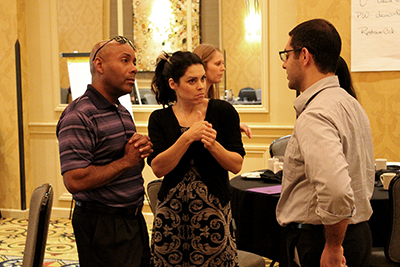
AccessComputing capacity building activities are funded by the National Science Foundation (#CNS-1539179). Any opinions, findings, and conclusions or recommendations expressed in this material are those of the CBI presenters and project staff and do not necessarily reflect the views of the National Science Foundation.
AccessComputing
University of Washington
Box 354842
Seattle, WA 98195-4842
accesscomp@uw.edu
www.washington.edu/accesscomputing/
206-685-DOIT (3648) (voice/TTY)
888-972-DOIT (3648) (toll free voice/TTY)
206-221-4171 (FAX)
509-328-9331 (voice/TTY) Spokane
AccessComputing Principal Investigators:
Richard Ladner, PI
Sheryl Burgstahler, Co-PI
Amy J. Ko, Co-PI
Jacob O. Wobbrock, Co-PI
Brianna Blaser, Project Coordinator
© 2016 University of Washington. Permission is granted to copy this publication for educational, noncommercial purposes, provided the source is acknowledged.